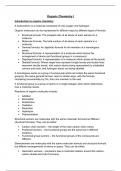Summary
Summary Edexcel A-Level Chemistry: Topic 6 - Organic Chemisty I (Notes and Exam-style questions)
- Course
- Institution
This pack includes detailed notes on organic chemistry I, as well as some exam style questions related to the topic. Organic chemistry I is a content heavy topic consisting of many difficult-to-learn, complicated organic mechanisms that many students struggle to learn and understand. Luckily for yo...
[Show more]



